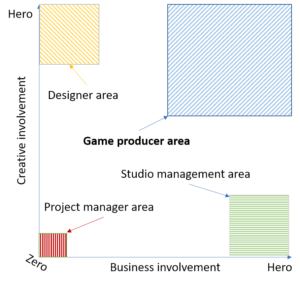
Nov 23, 2017
It is an understatement to say that game production is one of the less understood roles in the game industry. A few minutes of web searching about the role is bound to unearth contradictory impressions. Relevant answers in Quora will mostly say that producer are project managers in the entertainment industry. A quick search on the web for game producer positions will bring up vastly different responsibilities, ranging from a project manager role to more of a game director role. However, if we now search for famous producers, you find some of the most iconic designers in the gaming industry are also producers– think Sid Meier, Shigeru Miyamoto, Ron Gilbert and Hideo Kojima among others.
To better understand what is a producer let’s review what all producer roles have in common and where do they differ.
Similarities across all producer roles:
At a high-level everyone agrees that a game producer is someone whose task is to make sure a complete, non-buggy, game is released on time and budget.
The producer acts as a facilitator to ensure creative (art, music, and video), engineers and designers are all performing at their best, have no obstacles and communication between these groups flows freely and often. In most cases the producer will also keep the team’s burn rate, keeping track of how fast the company is expending money and what risks and obstacles are in the way of shipping a good game.
Differences in the producer role:
Most disagreements can be mapped to one of these four categories:
- Relationship with developer team: Internal vs. External – embedded to the developer vs. External
- Level of direct agency over the team: Interact with team members vs. Interact with leads only
- Level of creative involvement: game director vs. no creative input
- Level of business involvement: game champion vs. contractor
Relationship with developer team:
| Relationship with Developer | Responsible for | Day to Day activities | Usually works with |
|---|---|---|---|
| Internal (Developer Producer) | • Oversee development • Track risks • Establish information transparency • Represent the game in green-light process meetings | • Remove obstacles highlighted by development team • Keep track of current burn rate • Ensure that all project level documents are updated and accessible • Act as either Scrum Master or Product Owner in an agile team or as product owner in a Scrum of Scrums (If Agile studio) | • Lead Artist • Lead Designer • Lead Engineer • QA Lead • Publisher • Producer • Development Team • Public Relations |
| External – embedded (Publisher Producer) | • Represent publisher's interests • Communicate progress back to publisher • Track risks • Oversee development (sometimes) | • Report on game progress and risks • Support development team • Work with designers to weave publisher's requests into the game • Approve release sprints and participate in release planning (If Agile studio) | • Developer Producer • Lead Designer • Public Relations |
| External (Publisher Producer) | • Oversee business support departments (Sales, Marketing, Management) • Gatekeepers/stakeholders on the green-light process • Represent the game at publisher only meetings | • Review progress • Coordinate releases and promotions • Raise awareness across the publisher, the industry, and gamers • Track return on investment | • Publisher’s studio management • Publisher QA Lead • Marketing, Sales, and Operations • Developer Producer |
Level of direct agency over the team:
Senior producers usually lead developers teams, from an organizational hierarchy point of view. The reason is that the producer is responsible for shipping a game, all others are only involved in their particular discipline (art, engineering, designer). However, depending on the team size and its production practices the producers might only interact with the leads. In that case, every person inside a discipline would report to its lead and the leads, in turn, report to the producer.
The developer’s methodology is another factor that might impact the level of interaction the producer has with individual team members. Developers using Scrum are more likely to have producers on the ground, embedded into agile teams as a scrum master or product owner. On the other hand, more traditional studios might prefer to have the producer concentrate on planning meetings with the leads.
It is important to know that in most cases the producer is removed from hiring and promoting individual contributors, these decisions are the purview of the different leads. However, a producer’s evaluation carries weight.
Level of creative involvement:
For a long time, the industry thought that it made sense to entrust production to game designers (or game design to producers), as it seems logical that the person in charge of the vision would be the one most invested in getting the see it realized.
Designer/Producer convergence was at its highest around the mid-90s, a time of mid-size studios and relatively simple asset pipelines. As 3d games started to become more common in the late 90s / early 00s, complexity began to grow exponentially, and AAA teams doubled or tripled in size. This new environment favors more differentiation between roles: It is incredibly challenging to manage a large group, leading the game’s design and also handle the publisher relationship and the other business aspects of shipping game.
The modern consensus is that dedicated producers and designers are the way to go. Some developers take this all the way and don’t involve their producers in the creative aspect of the game. Most developers, however, prefer to have producers share creative responsibility for the game with designers. That way designers can concentrate on “finding the fun” (game mechanics, level & character design) while producers can provide structure and help prune unnecessary mechanics and features to ensure the game ships within budget and schedule. Thus, these producers are co-wardens of the game’s vision.
Similarly, most producers on the publisher side have a significant say in the game’s creative direction. Producers that are embedded in a developer team have to make sure the end product is fun and has a market. Dedicated publisher producers also help shape a game’s vision, albeit in a more indirect way: they influence the developer’s decisions through their interaction in game demos, communication with the developer’s producer, and their role as gatekeeper in the green-lighting process.
Level of business involvement:
One of the less understood functions of a game producer is to act as the champion and cheerleader of the game. This confusion stems from the use of the term producer in other areas of the entertainment sector, in particular, the music and video industries.
Producers in the audio industry are the link between the record label and the rock stars, working hand to hand with them to refine their sound, but also directing the record’s image (cover, booklet) and marketing. Their job is broadly defined, having to balance the star’s ego, while refining the music and providing to the needs of the record label.
Producers in the video industry are either the money person (Executive Producers), the schedule person (Producers) or the coffee person (Assistant Producer). Their job description is narrow and well defined.
The first game producers were introduced by Trip Hawkins, co-founder of EA, and modeled after the music’s industry producers. Back then game producers were expected to be the counterpart to the star developer. A person with enough creative power on its own to gain the respect of the designer, but with enough business sense to ground them to the realities of development – For a more in-depth analysis of game production’s history and present be sure to check Nick Laing’s video at GDC Europe 2015
The modern game producer inherits this tradition: A producer is responsible for working with the publisher’s marketing department to understand what is the market for the game, its potential size and how better to reach the target persona. A producer is also expected to lead internal and joint developer/publisher reviews of the game, making a case for the game over several competing projects. Finally, the producer should also be a point person for the external press – if the producer is not passionate about their game, it is unrealistic to think that the typical gamer will.
What this means:

Game producer role creative and business involvement vis a vis other roles
Game production as a discipline stands apart from traditional project management regarding creative and business involvement. Game producers have a greater emphasis on the game as a product; they are the game’s champion.
The confusion between both fields stems from the simple fact that a great producer will have to be, at the very least, a good project manager. Project managers and more project management skills are crucial to the industry’s effort to eradicate crunch, and without them hardly anything will get done.
In essence, the modern game producer is a cross between a project manager and a product manager, exactly as Trip Hawkins defined it.
“…they’re a little like book editors, a little bit like film producers, and a lot like product managers.” Trip Hawkins, EA co-founder











